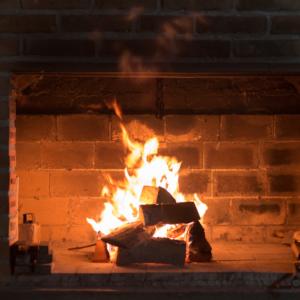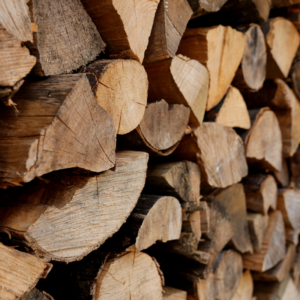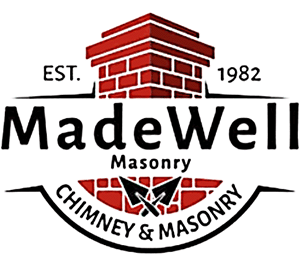Cold days call for crackling fires. Nothing brings warmth to this time of year, when the winter days stretch on, like a welcoming blaze in the fireplace. Unfortunately, starting a fire in a cold chimney can be a difficult task.
What Makes Starting a Fire in a Cold Chimney So Tricky?
 Maybe you’ve had the experience of trying to get a fire going in the coldest months only to have it smothered, burn weakly, or release smoke into your home instead of up the flue. Why does this happen?
Maybe you’ve had the experience of trying to get a fire going in the coldest months only to have it smothered, burn weakly, or release smoke into your home instead of up the flue. Why does this happen?
For warm air to rise, it has to displace the cold air above it. Since cold air is denser than warm air, this displacement happens naturally. But when cold, dense air is tumbling down your chimney, it creates a narrow, invisible barrier that you’re fighting against to start your fire. The descending cold air will smother your fire and cause inefficient burning, and airflow going the wrong direction can force smoke and carbon monoxide into your home – rather than up the chimney and out.
These aren’t just inconveniences. A smoky fire is inconvenient and unpleasant, yes – but it can also lead to respiratory issues or home damage, and carbon monoxide exposure can be lethal. Increased smoke from incomplete combustion of firewood also contributes to the accumulation of creosote in the chimney flue, which is a fire hazard.
Fortunately, that block of cold air doesn’t have to stop you from enjoying your fireplace when you want to use it most. Here are some helpful tips that should pave the way to the hot, crackling fire you’re after.
Tips to Get Your Fires Going
1. Warm the flue.
Step one is to get that chimney primed for a fire by warming it up.
- Roll a newspaper up into a cone.
- Light it and carefully hold it up in the throat of your chimney.
- The paper will readily ignite, providing a stream of concentrated heat for your smoke to follow.
After a few minutes, your chimney will have been primed with enough warmth to stop cold air from smothering your fire.
2. Consider your damper.
To give yourself a huge advantage in combating your cold chimney woes, consider upgrading to a top-sealing damper. A top-sealing damper is a device that sits at the top of the chimney and helps to keep cold air from entering. By preventing the cold air from entering, the damper can both a) help diminish drafts down the chimney and b) keep the baseline temperature inside the chimney more amenable to smooth fire-starting.
Throat dampers are also useful in sealing off your firebox when not in use and allowing smoke to be released when fires are lit, but they are also more prone to warp, which then compromises the tightness of the seal. The better the seal, the greater the ability to keep your flue more warmer and clear of obstructions. Because of its location, a top-sealing damper seals securely and is an excellent line of defense against precipitation, debris, and critters that can cause deterioration and become fire hazards.
3. Build fires strategically.
It might go against what you learned in scouts, but many experts suggest a top-down approach to building fires. Top-down fires have to do with log placement. The largest logs are positioned at the bottom of your firebox, with middle-sized pieces placed on them next, and quick-igniting kindling on top. This helps prime your flue, as the kindling will warm your flue before moving down to the larger pieces of wood below.
Other advantages? Your upside-down fire should be easier to light, it won’t collapse in on itself (sending sparks flying), it will achieve the desired temperature more quickly, and it will burn more efficiently.
4. Fuel fires properly.
 Using improper fuel is always the wrong move. What do we mean by improper fuel? Simply put – anything except well-seasoned firewood. Seasoned firewood is wood that’s been allowed to dry slowly after being cut through proper storage and air circulation. All wood contains some water, but the ideal moisture content for making fires is 15-25%.
Using improper fuel is always the wrong move. What do we mean by improper fuel? Simply put – anything except well-seasoned firewood. Seasoned firewood is wood that’s been allowed to dry slowly after being cut through proper storage and air circulation. All wood contains some water, but the ideal moisture content for making fires is 15-25%.
Damp or green firewood doesn’t burn as completely or efficiently as cured firewood. This has a number of undesirable side effects: increased build-up of creosote and soot, less heat output, and a smokier fire. It will also be more difficult to light and smolder when it does, and coupled with a cold chimney will be a recipe for total frustration.
There are numerous reasons to use exclusively properly seasoned firewood in your wood burning fireplace, and one of them is ease of ignition – whatever the weather. Seasoned hardwoods will give you a long, hot burn once ignited, but if you’re struggling to get them going, try starting with softwoods, which ignite more readily, to encourage them along.
5. Leave a layer of ash behind.
Leaving an ash bed of about two inches in your firebox is very advantageous when the weather’s cold. This insulates your fireplace, making starting fires easier. Just remember to scoop them down when they get too thick so they don’t inhibit airflow to your logs, since this would make them counterproductive.
What’s Next? Rely On Us
Chimney care and maintenance is important, and so is thinking through how to use your system optimally. Fortunately for homeowners in Memphis and its surrounding cities, we’re experts when it comes to that.
If you’re considering upgrading your chimney damper, need to schedule your yearly inspection, or have concerns about what may be hindering your operation, efficiency, and ease of fireplace use, reach out to us today to get in touch with our knowledgeable, service-oriented sweeps.
Call 901-443-1036 or book online now.

Recent Comments